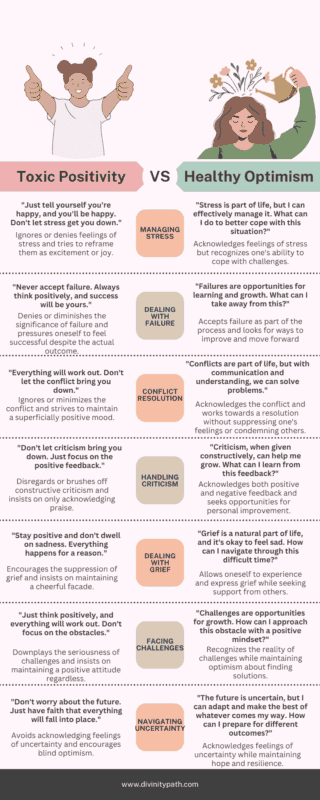What Is The Difference Between Healthy Optimism And Toxic Positivity?
In a world constantly inundated with inspirational speeches and motivational quotes, it seems that being optimistic is essential for survival. But where do we draw the line between healthy optimism that encourages progress and toxic positivity? Let’s uncover the secrets between healthy optimism and toxic positivity.
Some argue that ‘positive thinking’ is the key to happiness and success, but this mantra, often heard, can transform into something entirely different if it crosses the line into unhealthy behavior patterns. As Albert Einstein once said, “Reason is capable of inventing things beyond reason.” And this is precisely what can happen when we immerse ourselves in the world of positivity.
How To Easily Get Out Of Limiting Beliefs About Everything?
What is healthy optimism?
The line between healthy optimism and toxic positivity is very thin. Healthy optimism is based on reality and reasonable expectations. So, it brings confidence and awareness that also guides us through moments when things don’t go as planned.
Healthy positivity allows us to feel all emotions, not just the positive ones but also the ‘bitter’ ones. Regardless of whether we are angry, sad, or disappointed, we do not suppress our emotions but acknowledge and accept them. Perhaps we say to ourselves, “It’s okay to be sad; I’m only human.”
We all carry responsibilities on our shoulders, and healthy optimism helps us accept responsibility for our decisions and actions without blaming others or circumstances. We can introduce changes if we are aware of our influence on them. If we constantly blame others for our lives, we will not create any change, agree?
Revealed, What Happens If You’re Too Hard On Yourself?
Do you have healthy optimism? Let’s look at the signs:
- You are able to see the positive aspects of a situation, but remain realistic about obstacles and challenges that may arise.
- You do not avoid difficult situations, but accept them as opportunities for growth and learning. So, you focus on your abilities and possibilities to overcome obstacles.
- You accept failures and mistakes as part of the life process.
- You adapt to changes and unforeseen situations without losing your positive outlook on the future.
- You share your optimism and hope with other people without ignoring their problems or emotions.
- Despite having an optimistic view, you acknowledge that negative emotions are part of the human experience.
- You are aware of your abilities and strive for happiness but are not dependent on external circumstances for your well-being.
- You believe that even good things can arise from unpleasant moments.
- You take responsibility for your mistakes.
What about toxic positivity?
Toxic positivity is an entrenched belief that we must always remain positive regardless of circumstances. It encourages us to bury our negative emotions and, simply put, ‘play’ positive emotions. Phrases like ‘Look on the bright side’ or ‘Stay positive’ are familiar to everyone. If we constantly force ourselves into constant joy and a smile on our face while suppressing all negative emotions, we can expect consequences. More on that shortly.
Recognize the difference between healthy optimism and toxic positivity
We all find ourselves at times in a situation where a close person expresses the difficulties they are facing, and our reaction is something like this: “Everything will be fine, don’t worry.” There is absolutely nothing wrong with these encouraging words, of course, if done in a supportive and compassionate manner. I believe that a person facing a challenge yearns for us to listen to them and show understanding. Additionally, it is important to offer our presence, not just empty words. Perhaps we spice up the situation with helpful advice or help find a solution.
How To Develop Resistance To Stress And Maintain Your Health
The essential differences lie in the fact that healthy optimism encourages us to accept and address our feelings, even the negative ones, while toxic positivity tries to ignore or push away those feelings.

Are there consequences of toxic positivity?
Toxic positivity can have serious consequences for our well-being and emotional health. Among them are:
- When subjected to toxic positivity, we may feel like we have no space to express negative feelings. Instead of facing our emotions, we suppress them, which can lead to increased stress and anxiety.
- An overly optimistic approach may mean that we do not listen to or understand the real problems of other people.
- Ignoring the negative aspects of life can lead to losing touch with reality. This can lead to unrealistic expectations and disappointments when facing problems that cannot be solved by simple positive thinking. Positivity sometimes cannot solve our problems; it is our actions and seeking solutions that are important.
- When subjected to toxic positivity, we may feel guilty or ashamed of our negative feelings. For example, if we are sad or angry but try to be positive, we may experience additional pressure.
- Pretending to be happy and positive when we are not, we lose our authenticity and self-confidence. When we try to present a false image, we distance ourselves from the truth about ourselves and our feelings, which can lead to a loss of connection with our own identity. Wearing a mask 24/7 is exhausting, especially when many jobs require it. Which can be very exhausting.
Kristin Howard, a licensed marriage and family therapist, says there is nothing wrong with uttering positive affirmations or fostering positive thinking, but it is crucial to practice realistic positivity. Life occasionally throws obstacles and challenges at us, and if we deny, do not acknowledge, and do not accept the ups and downs of life that we all experience, toxic positivity makes it difficult to get through tough times.
Recognize toxic positivity in yourself and others
- Denial of problems and not facing them.
- Feeling guilty for being sad, angry, disappointed, or having a bad day.
- Hiding feelings from others because they seem socially unacceptable.
- Concealing and masking how you truly feel.
- Always looking on the bright side in every situation, no matter how serious or difficult it is.
- Instead of recognizing the seriousness of problems or challenges, you minimize or deny them.
- Often pretending to be happy and cheerful, even when it is not true. (Forced smiles or exaggerated optimistic statements).
- Avoiding conversations or situations that could trigger your negative emotions or reveal the reality of the situation.
- Instead of listening to others and offering support, trying to convince them that everything is fine.
- Rejecting support in difficult situations.
- Trying to reassure people with statements like: ”It could be worse…”
- Expecting everyone around you to always be positive and happy.
- Procrastination of problems.
Conclusion
It is important to know the differences between healthy optimism and toxic positivity, as it is beneficial for our mental and emotional well-being. While healthy optimism encourages us to accept and address our negative feelings and face problems in a realistic way, toxic positivity can lead to the suppression of emotions and unhealthy behavior patterns.
Recognizing one’s own emotional limitations and seeking help in coping with life’s challenges is a sign of self-care, maturity, and personal responsibility. Instead of seeing it as a sign of weakness, this behavior should be viewed as a positive step towards self-care and maintaining good mental health. (Oliveira & Colombo, 2020) I wish you all the best until next time when I will share tips on how to overcome toxic optimism.









